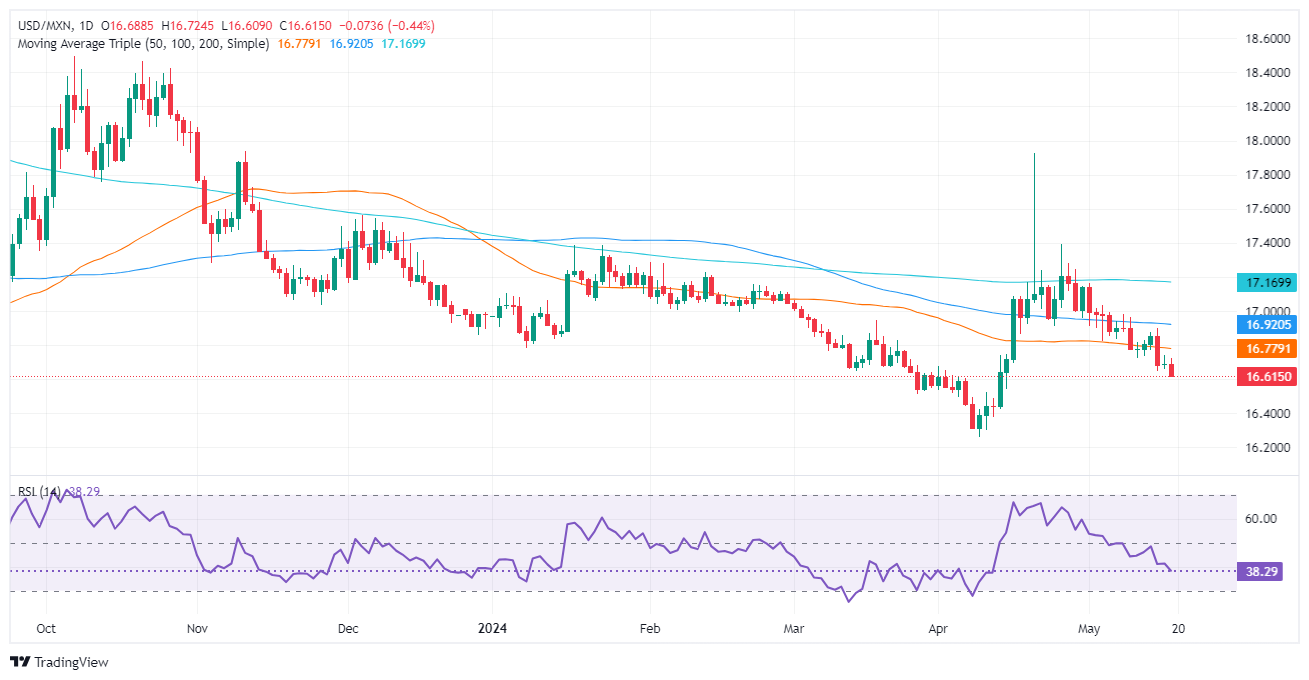- Mexican Peso climbs sharply as USD/MXN surpasses 2023 low of 16.62.
- Banxico's Deputy Governor Irene Espinosa's comments on rate cuts support Peso's rally.
- US inflation data sparks speculation of Fed rate cuts,with futures market indicating 41 bps reduction by year-end.
The Mexican Peso continues to record gains versus the US Dollar, refreshing its four-week high as the rally continued. In an interview, Bank of Mexico (Banxico) Deputy Governor Irene Espinosa was hawkish, boosting the Mexican currency. Meanwhile, US inflation data revealed during the week was mixed, though it reignited speculation that the Federal Reserve (Fed) would lower interest rates in September. The USD/MXN trades at 16.61, below the 2023 low of 16.62.
Mexico’s economic docket featured Banxico’s Deputy Governor Espinosa, who said the March rate cut was premature and would delay inflation’s convergence to the bank’s target. “The monetary restriction that was needed to maintain convergence (of inflation to the target) within the horizon that we had planned was reduced,” Espinosa said.
In the meantime, US inflation resumed its downtrend after stalling for six months, according to the US Bureau of Labor Statistics (BLS). The core Consumer Price Index (CPI) ebbed lower from 3.8% to 3.6% YoY in April, easing pressure on the Fed.
After the data, US equities rallied to new all-time highs, while the Greenback tumbled sharply, following the path of US Treasury yields. According to the fed funds rate December 2024 futures contract, expectations that the Fed would lower rates jumped from 36 basis points (bps) to 41 bps toward the end of the year.
Data from the CME FedWatch Tool shows odds for a 25 bps rate cut at the September meeting remain at 83%, lower than Thursday’s 87%.
Data-wise, the US Conference Board revealed the Leading Economic Index continued to fall in April. “Another decline in the U.S. LEI confirms that softer economic conditions lay ahead,” said Justyna Zabinska-La Monica, senior manager of business cycle indicators at The Conference Board.
Daily digest market movers: Mexican Peso surges amid Espinosa’s hawkish stance
- Banxico is beginning to split among its members. Governor Victoria Rodriguez Ceja said on Monday that the bank would discuss lowering rates in the upcoming meeting on June 29. Deputy Governor Espinosa commented that lowering rates in March might have delayed inflation convergence toward the central bank’s target by two quarters.
- Mexico’s economic docket next is expected to release Retail Sales on May 20, followed by the Gross Domestic Product (GDP), inflation figures and Banxico’s minutes on May 23.
- April's data show that Mexico’s headline inflation is reaccelerating. However, core prices are falling. This spurred Banxico’s revision to its inflation projections, with the bank expected to hit its 3% target toward the last quarter of 2025, later than March’s estimates for Q2 2025. Core inflation is projected to hit 3% in Q2 2025.
- The CB Leading Index decreased by 0.6% in April to 101.8 (2016=100) after diminishing by 0.3% in March. Over the six-month period between October 2023 and April 2024, the LEI contracted by 1.9% — a smaller decrease than its 3.5% decline over the previous six months.
- The US jobs market continues to slow down after the Nonfarm Payrolls report for April. This, along with the last two Initial Jobless Claims reports, suggests the labor market is cooling, helping the Fed to curb inflation.
- Investors have become optimistic that the Fed may cut rates this year after US inflation data showed the downtrend is resuming, while Retail Sales remained unchanged.
- Richmond Fed President Thomas Barkin stated that inflation is coming down, but that it will “take more time” to hit the Fed’s target.
Technical analysis: Mexican Peso climbs sharply as USD/MXN falls below 2023 low
The USD/MXN downtrend continues even though buyers pushed the exchange rate past close to the 50-day Simple Moving Average (SMA) near 16.77. Momentum favors Mexican Peso holders as the Relative Strength Index (RSI) remains in bearish territory, aiming downwards.
If USD/MXN extends its losses beneath the psychological 16.50 figure, that could open the door to test the current year-to-date low of 16.25.
Conversely, if buyers reclaim the 50-day SMA at 16.78, it could exacerbate a rally toward the 100-day SMA at 16.92. Once cleared, the next supply zone would be the 17.00 psychological level. In that event, the next stop would be the 200-day SMA at 17.17.
Mexican Peso FAQs
The Mexican Peso (MXN) is the most traded currency among its Latin American peers. Its value is broadly determined by the performance of the Mexican economy, the country’s central bank’s policy, the amount of foreign investment in the country and even the levels of remittances sent by Mexicans who live abroad, particularly in the United States. Geopolitical trends can also move MXN: for example, the process of nearshoring – or the decision by some firms to relocate manufacturing capacity and supply chains closer to their home countries – is also seen as a catalyst for the Mexican currency as the country is considered a key manufacturing hub in the American continent. Another catalyst for MXN is Oil prices as Mexico is a key exporter of the commodity.
The main objective of Mexico’s central bank, also known as Banxico, is to maintain inflation at low and stable levels (at or close to its target of 3%, the midpoint in a tolerance band of between 2% and 4%). To this end, the bank sets an appropriate level of interest rates. When inflation is too high, Banxico will attempt to tame it by raising interest rates, making it more expensive for households and businesses to borrow money, thus cooling demand and the overall economy. Higher interest rates are generally positive for the Mexican Peso (MXN) as they lead to higher yields, making the country a more attractive place for investors. On the contrary, lower interest rates tend to weaken MXN.
Macroeconomic data releases are key to assess the state of the economy and can have an impact on the Mexican Peso (MXN) valuation. A strong Mexican economy, based on high economic growth, low unemployment and high confidence is good for MXN. Not only does it attract more foreign investment but it may encourage the Bank of Mexico (Banxico) to increase interest rates, particularly if this strength comes together with elevated inflation. However, if economic data is weak, MXN is likely to depreciate.
As an emerging-market currency, the Mexican Peso (MXN) tends to strive during risk-on periods, or when investors perceive that broader market risks are low and thus are eager to engage with investments that carry a higher risk. Conversely, MXN tends to weaken at times of market turbulence or economic uncertainty as investors tend to sell higher-risk assets and flee to the more-stable safe havens.
Information on these pages contains forward-looking statements that involve risks and uncertainties. Markets and instruments profiled on this page are for informational purposes only and should not in any way come across as a recommendation to buy or sell in these assets. You should do your own thorough research before making any investment decisions. FXStreet does not in any way guarantee that this information is free from mistakes, errors, or material misstatements. It also does not guarantee that this information is of a timely nature. Investing in Open Markets involves a great deal of risk, including the loss of all or a portion of your investment, as well as emotional distress. All risks, losses and costs associated with investing, including total loss of principal, are your responsibility. The views and opinions expressed in this article are those of the authors and do not necessarily reflect the official policy or position of FXStreet nor its advertisers. The author will not be held responsible for information that is found at the end of links posted on this page.
If not otherwise explicitly mentioned in the body of the article, at the time of writing, the author has no position in any stock mentioned in this article and no business relationship with any company mentioned. The author has not received compensation for writing this article, other than from FXStreet.
FXStreet and the author do not provide personalized recommendations. The author makes no representations as to the accuracy, completeness, or suitability of this information. FXStreet and the author will not be liable for any errors, omissions or any losses, injuries or damages arising from this information and its display or use. Errors and omissions excepted.
The author and FXStreet are not registered investment advisors and nothing in this article is intended to be investment advice.
Recommended content
Editors’ Picks

Gold sits at fresh record high above $3,300 as US Dollar wilts on trade woes
Gold price remains within a striking distance of new record highs above $3,300 on Wednesday. Persistent worries about the escalating US-China trade war and US recession fears revive brroad US Dollar downtrend, boosting the traditional safe-haven Gold ahead of Fed Powell's speech.

EUR/USD holds firm above 1.1350 amid renewed US Dollar weakness
EUR/USD is storngly bid above 1.1350 in European trading on Wednesday. The pair draws support from a fresh round of selling in the US Dollar amid persistent fears over US-China trade war and a lack of progress on EU-US trade talks. US consumer data and Powell speech are in focus.

GBP/USD hangs close to fresh 2025-high above 1.3250 after UK CPI data
GBP/USD holds its six-day winning streak and stays close to its highest level since October above 1.3250 in the European session on Wednesday. The data from the UK showed that the annual CPI inflation softened to 2.6% in March from 2.8% in February but had little impact on Pound Sterling.

BoC set to leave interest rate unchanged amid rising inflation and US trade war
All the attention is expected to be on the Bank of Canada this Wednesday as market experts widely anticipate the central bank to maintain its interest rate at 2.75%, halting seven consecutive interest rate cuts.

Future-proofing portfolios: A playbook for tariff and recession risks
It does seem like we will be talking tariffs for a while. And if tariffs stay — in some shape or form — even after negotiations, we’ll likely be talking about recession too. Higher input costs, persistent inflation, and tighter monetary policy are already weighing on global growth.

The Best brokers to trade EUR/USD
SPONSORED Discover the top brokers for trading EUR/USD in 2025. Our list features brokers with competitive spreads, fast execution, and powerful platforms. Whether you're a beginner or an expert, find the right partner to navigate the dynamic Forex market.




